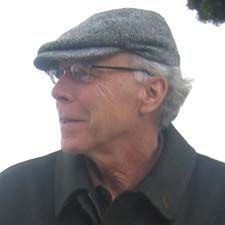Streets are narrow in Amsterdam. Minds are not. An atmosphere of tolerance prevails. That most basic freedom, personal mobility, is joyfully expressed in the ceaseless stream of cyclists gliding about the city.
Every thoroughfare is divided for pedestrians, cyclists and cars, with separate traffic signals for each. Given fair and equal access in this enlightened (and flat) city, cycling’s superiority becomes self-evident. Driving suddenly appears wasteful and self-indulgent. Walking seems slow and laborious. Aloof and elegant, Dutch women become more so when they ride past on black Gazelle or Batavus bikes.
At rest, the Dutch city bike looks sturdy and utilitarian. In motion it becomes a thing of beauty. There is a natural and comfortable position for easy riding and the Dutch city bike has evolved into it. There’s a natural pedaling cadence, as well. Most bikes in Amsterdam have only one gear and it’s perfect for level city riding. The exact ratio remains a mystery to me because the front and rear sprockets are enclosed by a chain guard that protects the chain from dirt and the pants from the chain.
The bike shop where I rented a single-speed tandem for my wife and I had a few bikes with multi-speed hubs and derailleurs on display. I asked the dealer why they might be needed in a city without hills. “Headwinds,” he replied with a knowing smile, “The Dutch mountains”.
As we explored the city by bike, we were untroubled by headwinds, although we couldn’t escape a soft summer shower. A little rain is a lot less bothersome when you have full fenders with a splash guard. We stopped in the Vondelpark and took refuge on a bench protected by the overhanging boughs of a sheltering tree. “This is a civilized place,” I remarked as we watched a mom ride by on a bakfiets, with two tow-headed kids in the cargo box, heedless of the rain. “It’s a city scaled for humanity, not cars. Green is more than just a slogan here.”
Watching the flow of two wheel traffic pass our bench, I realized that almost no one was wearing helmets or cycling apparel. In Amsterdam, cycling is more commonplace and natural than walking. To a Dutch cyclist, pulling on a helmet to go for a ride would seem as silly as wearing a helmet to walk to the corner grocery in Peoria.
One evening, over dinner in an Indian restaurant, my wife and I were nearly hypnotized by the endless stream of cyclists riding past our window into the Amsterdam night. Many were headed in the direction of the opera house, some of them wearing tuxedos and carrying their instruments on their backs.
Violins and cellos were not the only precious cargo we saw being transported through Amsterdam on two wheels. Once, during our too brief stay, I saw a dad gliding by with an infant strapped to his chest, papoose-style. That kid’s earliest memories, I thought, will be of flying along on two wheels feeling his father’s heartbeat.
Parking can be a problem. Signs in store windows ask cyclists not to block entryways with their bikes. The railings along the canals have become hitching posts for bikes. There is a multi-story bicycle parking structure at the train station designed to accommodate 7000 bikes and it’s always full.
There are two kinds of bicycles in Amsterdam: locked bikes and stolen bikes. Every bike comes equipped with a built-in rear wheel lock mounted on the seat stays. This is used for quick stops when the bike will not be out of the rider’s sight. A hefty chain wound around the frame, front wheel and a post or tree are required for longer stops. Theft insurance is a common add-on to any bike sale, and it isn’t cheap. In the store where I rented the tandem I overheard the dealer quote a three year policy for two hundred euros on a six hundred euro bike.
Occasionally, as we rode past sidewalk cafes, the sweet smell of burning ditch weed would transport me back a few decades to Berkeley, another city notable for its tolerance of cycling and other other less reputable diversions.
In some Amsterdam neighborhoods, window shopping takes on a startling new meaning. Riding through such a neighborhood on a tandem with his wife as stoker, a man is well advised not to turn his head and gawk. I tried not to. Still, when we stopped for coffee a short while later my wife asked, “Did you think those women were sexy?” There are questions to which there is no safe answer, so in the best Socratic tradition, I responded with a question of my own. “Do I have the right to remain silent?”
A truly civilized city makes its great art accessible to visitors and citizens alike. The Rijksmuseum, Van Gogh Museum, and the Rembrandt House are all easily reached by bike from virtually anywhere in Amsterdam. Refreshed by a brisk urban ride, the art lover arrives with mind and heart open to beauty. I don’t know a lot about art, but I appreciate greatness when I see it. The works of Vermeer, Rembrandt and Van Gogh are breathtaking. Pilgrims by the thousands stand before them every day and are profoundly moved, without always knowing or caring exactly why.
Although its energetic heart thrives, the Dutch empire is long dead. It’s tentacles, like those of every other empire, have atrophied or been amputated. The works of its artists have outlasted those of its politicians and generals. Painters deal in truth and light and die poor. Politicians and generals deal in lies and darkness and die wealthy. Such were the thoughts of an itinerant cyclist lost in the labyrinth of a bicycle utopia, making his way home in the waning light.




